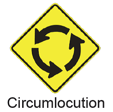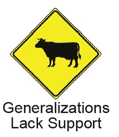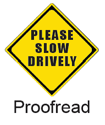The road to effective writing is strewn with obstacles
and diversions. Here are some warning signs for
writers to heed before setting fingertips to keyboard.
Of the many writing resources available to the architecture, engineering, and construction industry, the Construction Specifications Institute's Manual of Practice offers four C’s for effective communication:
-
CLEAR. Use proper grammar and simple sentence construction to avoid ambiguity.
-
CONCISE. Eliminate unnecessary words, but not at the expense of clarity, correctness, or completeness.
-
CORRECT. Present information accurately and precisely.
-
COMPLETE. Do not leave out important information.
The four C’s make a lot of sense given the realities of the AEC industry. How many times has a project problem or extra expense stemmed from a specification that was unclear, incorrect, or incomplete? How often is a client or supervisor in the field annoyed by having to read a lengthy document loaded with unnecessary words?
The road to the Four C’s, however, is strewn with obstacles and diversions. To steer clear of the most troublesome, here are some warning signs for writers to heed before setting fingertips to keyboard. If you’re a project editor or manager responsible for written deliverables, consider using these to provide direction to your project team, cautioning them about the consequences of reckless writing and failing to yield to your advice.

Ambiguity. Yogi Berra might have been thinking about and/or when he said “when you come to a fork in the road, take it.” Have you ever read a sentence that contained and/or that you didn’t have to read it twice—and/or more?
“The handling and/or disposal of hazardous materials is not included in the proposed scope of services.” Take a stance, make a decision, state what you mean. Choose and.
“All sign luminaries on the truss shall be repaired and/or replaced.” Choose or.
“Excessive amounts of free product that would otherwise impede or limit the field application will potentially affect the proposed costs and/or schedule.” Not sure? Keep it simple and choose “affect proposed costs, schedule, or both.”
Technical writing abounds with language that passes the buck. If an agreement specifies work to be completed in a timely manner or you’ve requested changes by COB or EOD—when is that? Whose close of business and end of day are we talking about? Using simple, objective language avoids misunderstanding—the deadline is 4 p.m. today. Using simple, objective language closes loopholes. What, for example, do practicable, if necessary, if applicable mean? And who decides? When the courts decide, they generally rule against those who drafted the ambiguous contract terms.

Circumlocution. Effective writing establishes trust; so who knows why someone would prefer to talk in circles, beat around the bush, avoid being frank, communicate in a roundabout way. Who is fooled? Can you translate this statement: “Apparent lack of concern for expeditious pursuit during ideal climactic conditions will require more extensive efforts and additional expense during the approaching, not too distant inclimate weather.” [We didn’t take advantage of the good weather, so it will cost us more moneyto finish the project before winter.]
Or translate this one: “Finally, regarding next steps, I concur with your way forward. For my own peace of mind I would like to have a teleconference next week to deep-dive on our SOW to ensure we have the specificity needed for project success and our mutual comfort. “ [I agree with your approach. Let’s go over the details in a teleconference next week.]

Generalizations Lack Support—or appear to. Here’s a statement from an existing conditons report: “There does not currently appear to be a public health service facility at this location.” Didn’t anyone go out and look? And this standalone statement is from a field inspection. “ The exterior joint sealant appears in fair condition but is likely past its life expectancy.” What does fair condition look like—and on what basis is it likely past its useful life? Both statements lacked support from specifics here or elsewhere in the reports.
It appears . . . that both writers didn’t do their homework, although appearances can be deceiving. In each case, the writers put in their time, but their results didn’t show up on the page. They either didn’t believe they had to be specific or were cutting corners by possibly copying statements from previous reports.
Now, turn your B.S. detectors on high for this example: “This study relies heavily on currently available information, including a myriad of existing studies previously completed by the agencies.” Heavily . . . . currently available . . . myriad? When pressed, the engineer who wrote this said the myriad of studies comprised three reports and the currently available information was a survey based on a dozen telephone interviews.
Whether writers are intentionally vague or not is irrelevant because the outcome is the same. Rather than bewilder readers, generalities raise questions about professional competence, legal responsibility, and personal ethics.

Significant Editing Required. “They will be contacting all the parties on the exception report, except for the ones that I have already taken off hold, or those that are on the report but are not on hold, and a few that we know that should not be contacted. If there are any parties in that group that should not be contacted, I will need to know. Also, if you do not want certain people contacted, please tell me why they should not be contacted.”
Start over. Cutting or rearranging the words already on the page won’t help. Before starting to write, think first: What am I trying to say? Like getting stuck in quicksand, the more the writer tried to climb out of this explanation, the heavier the text became and soon suffocated the meaning.

Proofread. “We intestinally left out the control panel because we intend to supply the clarifier drive and scum pumps from the new RAS/WAS MCC.” There’s a nice unintentional pun in this statement from a wastewater treatment report.
We all make mistakes, and typos slip through. When you give your writing the final read, take the attitude that you know you are going to find several per page. Often, typos are in large type, such as in titles and subheads. I remember seeing in 16-point font a caption to a photo with the attribution: “Aircraft designed by Blockhead Martin.”
Readers are usually patient and forgiving, ignoring the occasional mistake or rough spot in a document. There are limits, however, to a reader’s patience—especially a client who has paid money for quality work. The writing often is the work. After a writer ignores too many of the road signs seen here, readers can become annoyed.
The more infractions, the more frustration—as seen in this series of comments from a client’s review: “There are several vague terms in this sentence. The concept you are trying to describe is complicated; it needs to be explained clearly. . . . This description is unclear, and it seems inconsistent with the description in line 164 . . . . Okay, now I am totally confused. Please find the defibrillator.”
About the Author: Steven P. Schultz, Ph.D., the president of Writing at Work, Inc., provides writing and editing services along with training seminars to engineering and architectural firms across the U.S. As an editor and writer, he has helped companies improve their client correspondence, project documentation, proposals, and marketing materials. Contact Steve at writingatwork@msn.com or 813-854-1999.



